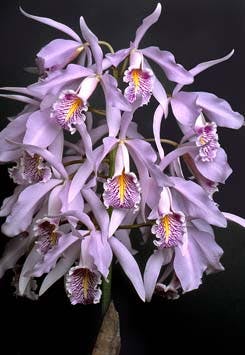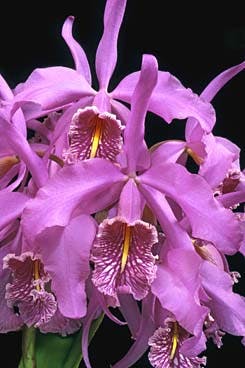The late Isaias M. Rolando, PhD, unravels the history of Cattleya maxima

Cattleya maxima 'Crownfox Delicado' AM/AOS
During the Virreynato del Peru expedition, Hipolito Ruiz, Jose Pavon and Joseph Dombey collected Cattleya maxima. This trio comprised the first botanical group assembled to document the native plants for the famous Flora Peruviana et Chilensis and arrived in Lima April 8, 1778. For 10 years they traversed the surroundings of Tarma, Huanuco, Cuchero and Pozuzo in the rainforests of central Peru. However, they never explored the areas of Quito and Loja, in Ecuador. While in Peru, Ruiz and Pavon started to train a third Spanish botanist, Juan Jose Tafalla, to carry on their exploration. Beginning in June 1785, and continuing until his death in 1811, Tafalla followed in Ruiz and Pavon's footsteps, collecting plant material and sending it to Spain. In May 1799 Tafalla set off to explore Loja, where he remained and collected for 10 years. After the French occupation in 1816, Ruiz died in Madrid, and difficult times forced Pavon to start mailing drawings and plant herbaria of the Peruvian expeditions to London. .
As stated in Lindenia, Aylmer B. Lambert acquired this botanical material and showed the herbaria to Dr. John Lindley, who concluded that a plant collected by Juan Tafalla in the Andes near Guayaquil, Ecuador, was a new Cattleya. Lindley had established the genus Cattleya in honor of Sir William Cattley in 1821, and described three species - Cattleya labiata (1821), Cattleya loddigesii (1823) and Cattleya forbesii (1823) - before publishing Cattleya maxima in 1831.
By 1842 explorer Hartweg had sent live plants of C. maxima to the Royal Horticultural Society in London. In 1866 the search for this species was resumed when Linden dispatched explorer Gustav Wallis to the region between Rio Tumbes and Rio Huancabamba. Wallis obtained plants that were sent to Linden's nursery in Brussels.
Two distinct forms of C. maxima - the "lowland type" and the "upland type" - occur (Withner, 1988). The elevations of the habitats range from 330 to 6,000 feet (100 to 1,800 meters) above sea level. The lowland type occurs near Guayaquil in the Pacific Coastal areas near this Ecuadorian port. Vegetatively it is "...gigantic compared to other cattleyas" (Withner, 1988). It stands 28 inches (70 cm) tall and is larger than any of the Cattleya labiata group. The number of quite-floppy-and-small flowers rendered in soft colors ranges from 12 to 25. In contrast, the upland form is similar in size to members of the Cattleya labiata complex. Four to six very dark 6-inch (15-cm) flowers are borne in a cluster.
Except for Cattleya aurea, C. maxima is the only Cattleya that grows on the Pacific side of the western slopes of the Andes in an extended area ranging from Peru northward through Ecuador and Colombia; it also occurs in Venezuela. In Peru it is called Flor de Navidad, Christmas Flower (Withner, 1988).
HYBRIDS

Cattleya maxima 'Crownfox' AM/AOS
In 1859 the famous orchid firm of Veitch and Sons registered the first Cattleya hybrid, and one of its parents was C. maxima. Named Cattleya Dominiana (maxima x intermedia), it honored John Dominy who first obtained orchid hybrids from seeds. This same firm registered other C. maxima hybrids in the last decades of the 19th century: Laeliocattleya Amesiana in 1884 (x Laelia crispa), Cattleya Chlois in 1893 (x bowringiana) and Cattleya Vestalis in 1899 (x C. dowiana). According to Sander's List of Registered Orchid Hybrids, there were 22 primary and three secondary C. maxima hybrids registered prior to 1925. No C. maxima hybrids were registered between 1925 and 1960. Since then through 1990, however, 15 C. maxima hybrids were registered.
According to Ernest Hetherington (1985), bifoliate cattleyas impart the shape of their lips to their progeny when hybridized with unifoliate cattleyas. However, it seems this is not the case with the monofoliate C. maxima. Hybrids within the genus Cattleya, such as Cattleya Coloramax (x bicolor), possess a C. maxima-like lip, as do intergeneric hybrids, such as Brassocattleya Fuchs Star (x Brassavola nodosa).
There are special horticultural characteristics to anticipate in future hybrids. Cattleya maxima (upland type) has been observed growing outdoors in California, Florida, Guayaquil and Lima, sometimes in full sun. We have grown C. maxima where it receives cool nights 40 F (5 C) and full sunshine, which suggests C. maxima possesses the ability to adapt to many climates, and, therefore, can be cultivated in a diversity of environments.
Well-grown plants produce two growths each year. Combining Laelia anceps hybrids with Cattleya maxima might yield improved orchids for growing outdoors where temperatures dip to freezing. Although the fragrance of C. maxima's flowers is unremarkable, there are a few clones of the upland type that do perfume the air of a small greenhouse in the morning.
COLOR FORMS
- var. alba There are two Ecuadorian forms. One was exhibited at the Guayaquil International Orchid Show in 1988. There is a Peruvian variety not yet presented at any show, but we have a previous record of another Peruvian alba form at the Botanical Garden of Heidelberg (Dr. Senghas, personal communication).
- var. coerulea One of the most beautiful coerulea forms was exhibited at the 1991 Guayaquil, Ecuador orchid show where it received an AM/AOS (86 pts.). This C. maxima 'Hector', AM/AOS, was raised by Padre Angel M. Andreeta. The flowers are spaced for an attractive presentation.
- var. concolor An Ecuadorian form with a lovely pure soft rose color and no veins in the lip, but with the usual yellow vein in the middle of the lip.o
- white sepals and petals. There are no colored veins inside the lip, which is pigmented a soft rose color.
- var. semi-alba From the highlands of Ayabaca, this form is published here in color for the first time. There is one division of the plant in Dr. Sergio Oliveria's collection (Sao Paulo, Brazil), from which he will prepare the botanical description.
- var. superba From the uplands of Northern Peru. The shape of the flower is similar to the upland type but the flower reaches 9 inches (22 cm) in good growing conditions. This cultivar has been selfed and the seedlings are healthy.
- var. venosa This has the type colors of the upland variety, but with dark venation in the petals. Without a doubt, the future appears bright for C. maxima - the greatest cattleya - whose true beauty is only now beginning to be appreciated.
References
Hetherington, Ernest. 1985. The bifoliate cattleyas - 1 - purples, pinks, and whites. Amer. Orchid Soc.Bull. 54(10): 1210-1219.
Withner, Carl. 1988. The Cattleyas and Their Relatives: Volume I, The Cattleyas. Timber Press, Portland.
Republished from the AOS Bulletin, May 1993








